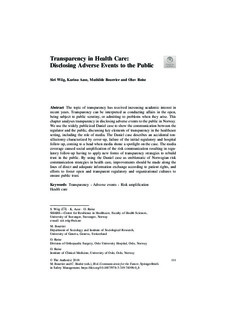| dc.contributor.author | Wiig, Siri | |
| dc.contributor.author | Bourrier, Mathilde | |
| dc.contributor.author | Aase, Karina | |
| dc.contributor.author | Røise, Olav | |
| dc.contributor.editor | Bourrier, Mathilde | |
| dc.contributor.editor | Bieder, Corinne | |
| dc.date.accessioned | 2019-03-01T13:12:41Z | |
| dc.date.available | 2019-03-01T13:12:41Z | |
| dc.date.created | 2018-07-06T13:30:18Z | |
| dc.date.issued | 2018 | |
| dc.identifier.citation | Wiig, S., Aase, K., Bourrier, M., Røise, O. (2018) Transparency in Health Care: Disclosing Adverse Events to the Public, In Bourrier, M., Bieder, C. (Eds.) Risk Communication for the Future : Towards Smart Risk Governance and Safety Management (pp. 111-125) Cham: Springer Open | nb_NO |
| dc.identifier.isbn | 978-3-319-74098-0 | |
| dc.identifier.issn | 2191-5318 | |
| dc.identifier.uri | http://hdl.handle.net/11250/2588291 | |
| dc.description.abstract | The topic of transparency has received increasing academic interest in recent years. Transparency can be interpreted as conducting affairs in the open, being subject to public scrutiny, or admitting to problems when they arise. This chapter analyses transparency in disclosing adverse events to the public in Norway. We use the widely publicized Daniel case to show the communication between the regulator and the public, discussing key elements of transparency in the healthcare setting, including the role of media. The Daniel case describes an accidental tonsillectomy characterized by cover-up, failure of the initial regulatory and hospital follow-up, coming to a head when media shone a spotlight on the case. The media coverage caused social amplification of the risk communication resulting in regulatory follow-up having to apply new forms of transparency strategies to rebuild trust in the public. By using the Daniel case as emblematic of Norwegian risk communication strategies in health care, improvements should be made along the lines of direct and adequate information exchange according to patient rights, and efforts to foster open and transparent regulatory and organizational cultures to ensure public trust. | nb_NO |
| dc.language.iso | eng | nb_NO |
| dc.publisher | Springer Open | nb_NO |
| dc.relation.ispartof | Risk Communication for the Future, | |
| dc.relation.ispartofseries | SpringerBriefs in Applied Sciences and Technology: Safety Management; | |
| dc.rights | Navngivelse 4.0 Internasjonal | * |
| dc.rights.uri | http://creativecommons.org/licenses/by/4.0/deed.no | * |
| dc.subject | safety management | nb_NO |
| dc.subject | sikkerhetsstyring | nb_NO |
| dc.subject | transparency | nb_NO |
| dc.subject | transparens | nb_NO |
| dc.subject | uønskede hendelser | nb_NO |
| dc.subject | health care | nb_NO |
| dc.subject | helsefag | nb_NO |
| dc.title | Transparency in Health Care: Disclosing Adverse Events to the Public | nb_NO |
| dc.type | Chapter | nb_NO |
| dc.description.version | publishedVersion | nb_NO |
| dc.rights.holder | © The Author(s) 2018 | nb_NO |
| dc.subject.nsi | VDP::Social science: 200 | nb_NO |
| dc.subject.nsi | VDP::Medical disciplines: 700::Health sciences: 800 | nb_NO |
| dc.source.pagenumber | 111-127 | nb_NO |
| dc.identifier.cristin | 1596115 | |
| dc.relation.project | SHARE - Centre for Resilience in Healthcare: 5091 | nb_NO |
| cristin.unitcode | 217,13,2,0 | |
| cristin.unitname | Avdeling for kvalitet og helseteknologi | |
| cristin.ispublished | true | |
| cristin.fulltext | original | |
| cristin.qualitycode | 1 | |

